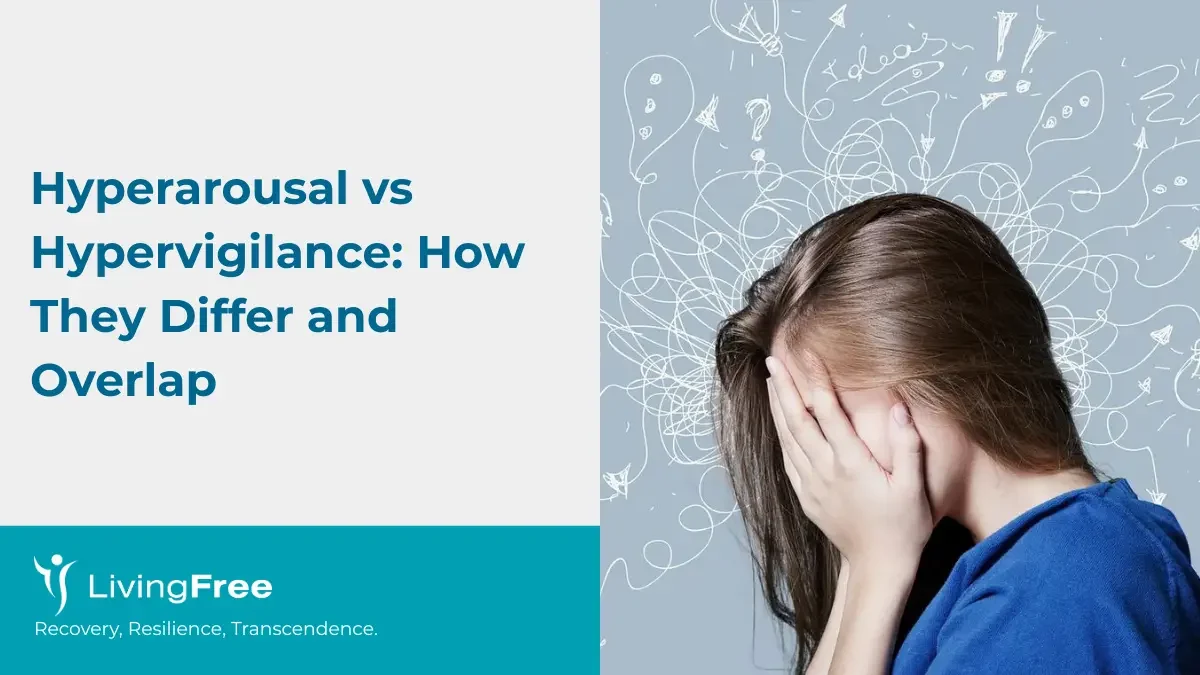When discussing trauma, stress disorders, or PTSD, two terms that often show up together are hyperarousal and hypervigilance. They sound similar, and they are connected, but they are not the same. Understanding how they differ helps individuals, caregivers, and clinicians recognize symptoms and choose the right strategies for recovery.
What Is Hyperarousal?
Hyperarousal is a heightened state of physiological, emotional, and behavioral activation. It occurs when the body’s fight-or-flight system stays switched on, even when there is no real danger.
Hyperarousal Is a Symptom of What?
Hyperarousal is not a diagnosis on its own. It is a symptom cluster commonly seen in:
- Post-Traumatic Stress Disorder (PTSD).
- Acute Stress Disorder (ASD).
- Generalized Anxiety Disorder (GAD).
- Panic Disorder.
- Survivors of trauma or unsafe environments.
- Chronic stress and burnout.
In the DSM-5, hyperarousal belongs to the “Alterations in Arousal and Reactivity” category.
Symptoms of Hyperarousal
Hyperarousal includes several symptoms, such as:
- Rapid heartbeat, sweating, fast breathing
- Irritability or anger outbursts
- Sleep disturbances
- Difficulty concentrating
- Exaggerated startle response
- Hypervigilance ← hypervigilance is part of this cluster
Hypervigilance is not separate from hyperarousal. It is one of its hallmark symptoms.
Hyperarousal Example: What It Feels Like In Real Life
You’re driving home, and a car suddenly honks. Even though it’s minor, your entire body reacts instantly: your chest tightens, your hands grip the wheel hard, and your breathing speeds up. Long after the moment passes, your body stays activated. You feel agitated, unusually jumpy at traffic sounds, and your mind keeps replaying the moment. You know it wasn’t dangerous, but your body stays stuck in a high-alert state. This lingering physical overreaction is a common example of hyperarousal.
What Is Hypervigilance?
Hypervigilance is a symptom within the hyperarousal cluster, especially in PTSD. It describes the state of being excessively alert and continuously scanning the environment for potential threats, even when you are safe.
Hypervigilance Is a Symptom of What?
Hypervigilance is most commonly a symptom of:
- PTSD (officially listed under the hyperarousal criteria)
- Acute Stress Disorder
- Anxiety disorders (GAD, Social Anxiety)
- Trauma survivors, including those without full PTSD
- Chronic stress or long-term exposure to unpredictable danger
How Hypervigilance Appears
- Constantly checking surroundings.
- Feeling unsafe in safe places.
- Jumpiness.
- Misinterpreting neutral sounds as threats.
- Muscle tension.
- Difficulty relaxing.
Because hypervigilance keeps the brain in a constant “on guard” mode, it becomes both a symptom of hyperarousal and a behavior that feeds into hyperarousal, creating a cycle.
Hypervigilance Example: What It Feels Like In Real Life
You’re walking through a shopping mall, but instead of enjoying the stores, your mind constantly monitors everything: people walking too close, loud footsteps behind you, someone reaching into their bag, or a group talking loudly. You watch faces, gestures, and movement patterns, trying to predict if anything could turn into a threat. You feel tense until you leave the crowd, even though nothing unsafe actually happened. This nonstop mental scanning for danger shows hypervigilance in daily life.
Are Hyperarousal and Hypervigilance the Same?
No, but they are deeply connected.
Hypervigilance is often a component of hyperarousal, but hyperarousal is a broader reaction that affects the entire nervous system. Hypervigilance focuses specifically on scanning, watching, and anticipating.
Hyperarousal vs Hypervigilance: Differences and Similarities
| Aspect | Hyperarousal | Hypervigilance |
|---|---|---|
| Definition | Body stuck in fight-or-flight mode; heightened physiological arousal | Excessive environmental scanning; mental and behavioral alertness |
| Type of Response | Physiological + emotional | Cognitive + behavioral |
| Primary Symptoms | Rapid heartbeat, sleep issues, irritability, tension, startle reflex | Continuous threat monitoring, jumpiness, inability to relax |
| Focus | Internal body reactions | External environment |
| Duration | Can persist all day | Often situational but habitual |
| Common in PTSD | Yes | Yes. often considered a symptom within the hyperarousal cluster |
| Root Cause | Nervous system dysregulation | Learned safety behavior after trauma |
| Energy Impact | Exhaustion from internal overactivation | Fatigue from constant monitoring |
| Can Occur Separately? | Yes | Rarely, often accompanied by hyperarousal |
| Overlaps | Both involve tension, anxiety, reduced sense of safety | Both can reinforce each other |
How Hyperarousal and Hypervigilance Influence Each Other
The relationship between the two is cyclical:
1. Hypervigilance fuels hyperarousal
When you constantly scan for danger, your sympathetic nervous system stays active. Making your heart race, muscles tense, and body ready to react.
2. Hyperarousal increases hypervigilance
When your body feels alert, jumpy, or on edge, your mind starts searching for explanations. Often leading you to look for threats.
This loop can make symptoms persistent unless intentionally addressed.
Why These States Happen?
Both hyperarousal and hypervigilance stem from:
1. Trauma conditioning
The brain learns that danger can appear unexpectedly, so it stays alert to protect you.
2. Changes in brain regions
- Amygdala becomes overactive
- Prefrontal cortex becomes underactive
- Hippocampus struggles to differentiate between past memories and present cues
3. Nervous system imbalance
The sympathetic nervous system fires too easily, while the parasympathetic (“rest and digest”) system becomes harder to engage.
How These Symptoms Affect Daily Life
Hyperarousal causes:
- Insomnia.
- Outbursts of anger.
- Difficulty focusing at work.
- Physical strain (blood pressure, muscle tension).
- Emotional overwhelm.
Hypervigilance causes:
- Avoiding social interactions.
- Fear in public space.
- Trouble feeling safe even at home.
- Misjudging harmless cues (e.g., footsteps, doors closing).
- Exhaustion from constant alertness.
Both reduce quality of life and may interfere with relationships, work, and overall well-being.
How to Manage Hyperarousal and Hypervigilance
1. Therapy
- EMDR
- Trauma-focused CBT
- Somatic therapies (e.g., somatic experiencing, sensorimotor psychotherapy)
- Exposure-based therapies
These help retrain the brain to separate past danger from present safety.
2. Nervous System Regulation Techniques
- Slow diaphragmatic breathing.
- Progressive muscle relaxation.
- Grounding (temperature, sensory exercises).
- Mindfulness focusing on body cues.
- Vagus nerve stimulation practices.
3. Lifestyle Adjustments
- Reducing caffeine.
- Establishing sleep routines.
- Gentle physical activity (yoga, walking).
- Reducing chronic stress where possible.
4. Medication (supervised by clinicians)
- Anti-anxiety or antidepressant medications.
- Sleep-support medications.
- Beta-blockers (in specific clinical cases).
When to Seek Professional Support?
If hyperarousal or hypervigilance:
- Interferes with work.
- Damages relationships.
- Causes constant exhaustion.
- Prevents normal daily functioning.
- Makes you feel unsafe even when you are safe.
It’s important to reach out to a mental health professional. Trauma-related symptoms are treatable, and you don’t have to handle them alone.
Final Thoughts
Hyperarousal and hypervigilance are closely related, but they’re not the same.
- Hyperarousal affects the body and emotions.
- Hypervigilance affects attention and behavior.
Both are common in trauma and PTSD and often appear together. Understanding the difference helps people recognize what they’re experiencing and seek more tailored support. Recovery is absolutely possible through therapy, regulation skills, and compassionate care.
Recognizing the distinction between hyperarousal and hypervigilance is a meaningful first step toward recovery. With proper treatment and daily regulation skills, long-term improvement is absolutely possible. Whenever you’re ready to move forward or ask questions, you can contact us, we’re here to help!
Related Post:


